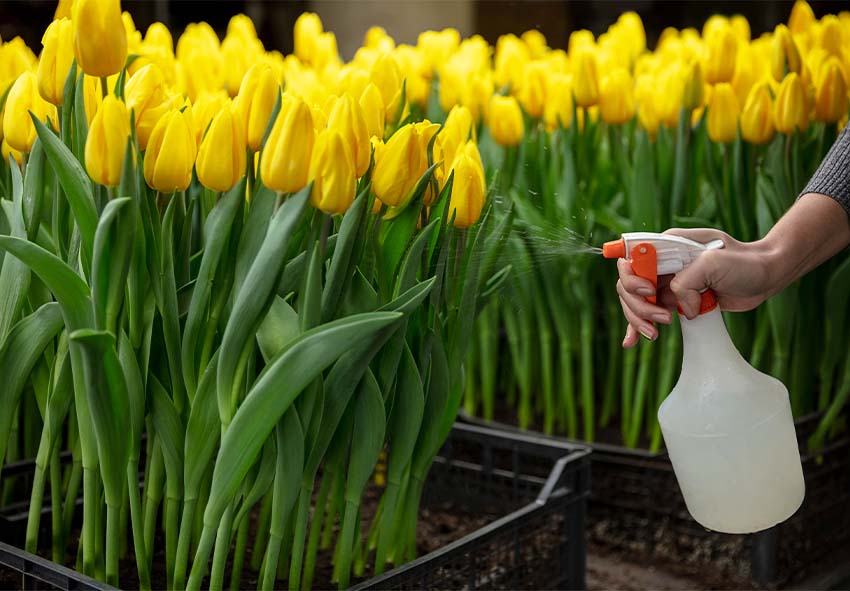Tulips are beloved for their vibrant blooms and are a highlight of many spring gardens. However, they are also vulnerable to a variety of pests and diseases that can damage foliage, deform flowers, or rot bulbs. In this article, you’ll learn how to protect tulips from pests and diseases through smart prevention and targeted treatment strategies. Our gardening blog is a perfect place to find all the information you need!
Common Tulip Pests

Pests can quickly weaken or destroy tulips if left unchecked. Recognizing the signs early and knowing how to manage infestations is key to preserving healthy plants.
Aphids and Their Impact on Tulips
Aphids are small, sap-sucking insects that often cluster on tulip stems and leaves. They weaken plants by draining nutrients and spreading viruses, such as the Tulip Breaking Virus. You’ll often notice sticky residue, curled leaves, and stunted growth—clear signs that your tulips need attention.
Slugs and Snails
Slugs and snails feed on young tulip shoots, buds, and petals, usually at night or during damp conditions. Their damage appears as ragged holes or chewed edges, especially near the base of the plant. They thrive in shady, moist areas, making mulched beds particularly vulnerable.
Bulb Mites and Root-Feeding Insects
Bulb mites and insects like root maggots attack tulips below the soil surface, damaging roots and bulbs. Infested bulbs often feel soft or show decay before sprouting. These pests are harder to detect but can cause long-term harm by reducing flower quality and plant strength.
Common Diseases in Tulips
In addition to pests, tulips are susceptible to several fungal and viral diseases. Knowing the symptoms and transmission methods can help gardeners act quickly and protect other nearby plants.
Tulip Fire (Botrytis tulipae)
Tulip Fire is a fungal disease that causes gray mold on stems and leaves, leading to shriveled flowers and distorted growth. It spreads easily in wet weather and through infected plant debris or bulbs. Once established, it can ruin entire patches of tulips within days.
Tulip Breaking Virus (TBV)
While TBV may cause beautiful streaks on petals, it’s actually a serious disease that weakens the plant over time. The virus is primarily spread by aphids and can remain in the garden if infected bulbs aren’t removed. There is no cure—infected plants should be discarded immediately.
Bulb Rot (Fungal or Bacterial)
Bulb rot occurs when tulip bulbs sit in overly moist or poorly drained soil. Fungal and bacterial pathogens thrive in such conditions, causing the bulbs to become mushy and discolored. This disease often leads to failure to sprout in spring and can persist in contaminated soil.
Preventative Measures
The best way to deal with tulip pests and diseases is to prevent them from taking hold in the first place. A few proactive steps can go a long way toward ensuring a healthy, thriving tulip display:
- Choosing Healthy Bulbs: Always purchase tulip bulbs from reputable sources that certify them as disease-free. Look for bulbs that are firm, plump, and free from blemishes or mold. Avoid any with soft spots, discoloration, or signs of damage.
- Proper Tulip Planting Practices: Well-drained soil is essential to prevent diseases like bulb rot. Plant tulips with enough space between them to allow airflow, which reduces moisture buildup. Make sure bulbs are planted at the correct depth to prevent heaving during winter freezes.
- Garden Hygiene and Crop Rotation:Clean up dead leaves and spent flowers at the end of the season to remove places where pests and fungi can overwinter. Disinfect tools regularly and rotate your tulip beds annually to prevent soil-borne diseases from building up.
Organic Pest Control

Using organic methods to protect your tulips is an environmentally friendly and effective approach to managing common garden pests. These techniques are ideal for gardeners who prefer chemical-free solutions or who grow tulips near pollinator-friendly plants. Here are two of the most effective strategies.
Natural Predators and Barriers
Encouraging beneficial insects and installing simple physical barriers can effectively deter common tulip pests without relying on chemicals. Here are some of the most reliable options:
- Ladybugs – These helpful insects feed on aphids and other soft-bodied pests that commonly target tulips.
- Lacewings – Known for devouring aphid colonies and thrips, lacewings are excellent natural pest controllers.
- Garden Netting – Fine mesh or floating row covers protect tulips from larger pests like deer, rabbits, and birds.
- Copper Tape or Rings – Effective against slugs and snails, copper creates a natural repellent barrier around plants.
- Crushed Eggshells or Diatomaceous Earth – Scatter around the base of tulips to deter crawling insects like cutworms and ants.
Homemade Sprays and Solutions
Simple mixtures made with ingredients like neem oil, garlic, or soap can repel insects without harming your plants. These sprays are easy to make and can be applied directly to tulip leaves in the early morning. Always test a small area first to avoid leaf damage.
Chemical Pest Control
In cases of severe infestations or persistent diseases, chemical pest control can be a necessary part of tulip care. When used responsibly, these products can quickly stop damage and protect blooms. Always follow label instructions and safety precautions when applying any chemical treatment.
Systemic Insecticides for Bulb Protection
Systemic insecticides are absorbed into the plant and provide long-term protection from underground pests like bulb mites and root maggots. Apply them when planting or early in the growing season to prevent larvae from attacking vulnerable bulbs. These products are especially useful in regions with recurring soil pests.
Targeted Fungicides for Disease Control
Fungicides are effective against common tulip diseases such as Botrytis blight or bulb rot. Use them at the first sign of leaf spotting, mold, or wilting. Reapply as directed during wet or humid weather to maintain protection and prevent the spread of fungal spores.
When to Use Chemical Controls
While tulips are relatively low-maintenance, certain pests and diseases can cause serious damage if left unchecked. In such cases, chemical treatments may be the most effective solution. Here are the main situations where using chemical controls is recommended:
- Severe Pest Infestations: If natural methods fail and pests like aphids, slugs, or bulb mites are damaging large sections of your tulips, chemical treatment may be necessary to prevent widespread destruction.
- Persistent Fungal Diseases: Diseases such as tulip fire (Botrytis) or advanced bulb rot can persist in soil or plant debris. Fungicides may be required when infections return year after year despite good hygiene practices.
- Rapid Disease Spread: When a disease or pest infestation is spreading quickly and threatens nearby plants, a targeted chemical application can help stop the issue before it escalates.
- Lack of Effective Organic Alternatives: In cases where organic or mechanical methods don’t yield results—especially with hidden pests like bulb mites or root maggots—chemical intervention may be the only effective solution.
- Protecting Valuable or Rare Varieties: If you grow rare, heirloom, or show-quality tulips, you may choose chemical treatments as a preventive or curative measure to ensure their survival and bloom performance.
Dealing with Infected Plants

Once pests or diseases take hold, swift action can help stop the spread and save the rest of your tulip display. Knowing what to remove and how to clean the area is critical.
Isolating and Disposing of Diseased Tulips
Remove infected tulips as soon as symptoms appear and do not compost the waste, as it can reintroduce disease. Place infected plants in sealed bags and discard them with regular trash. This helps prevent spread to healthy plants nearby.
Soil Treatment and Disinfection
If you’ve had problems with bulb rot or fungal infections, consider treating the soil with a fungicide or replacing it entirely. Wash gardening tools and gloves with a disinfectant before using them on healthy plants. In container gardens, change the potting mix and clean the containers thoroughly.
Conclusion
Tulips bring joy to spring gardens, but they also require vigilance to protect them from common tulip pests and diseases. By planting healthy bulbs, practicing good hygiene, and acting quickly at the first sign of trouble, you can enjoy a full season of beautiful blooms. Prevention and routine care remain the best tools for keeping your tulips thriving!
Frequently Asked Questions (FAQs) about Pest Control for Tulips
1. What are the most common pests that affect tulips?
Tulips are often targeted by aphids, slugs, snails, and bulb mites. Larger pests like squirrels, deer, and rabbits may also dig up or eat bulbs and flowers. Early detection and proper preventative care can help minimize damage and ensure a healthy bloom season.
2. How can I protect tulip bulbs from being eaten before they sprout?
To protect tulip bulbs, plant them deeply and cover the area with chicken wire or mesh. You can also add a layer of sharp gravel or crushed shells to deter digging animals like squirrels. Repellents or natural deterrents like blood meal can also help discourage bulb predators.
3. Are there effective organic methods for tulip pest control?
Yes, organic pest control methods include using neem oil for aphids, diatomaceous earth for slugs, and encouraging beneficial insects like ladybugs. Physical barriers like garden netting and copper tape also prevent pest access.
4. When should I use chemical pest control for tulips?
Chemical pest control should be a last resort when organic methods fail or an infestation is severe. Use targeted insecticides labeled safe for tulips, and always follow application instructions. Apply during early morning or late evening to protect beneficial insects and avoid plant stress.
5. Can I order tulip bulbs from your online store?
Yes, you can order tulip bulbs from our online store Dutch-bulbs.com. We offer a wide selection of tulip varieties suitable for different climates and preferences. Our bulbs are carefully sourced and stored to ensure they are of the highest quality.
Published: 25.07.2025
